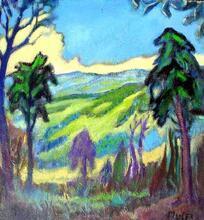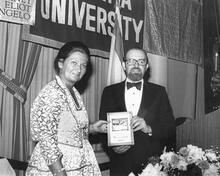Chana Orloff
Sculptor Chana Orloff was a part of the avant-garde circle of Montparnasse, the international movement of artists in Paris. After immigrating to Paris from Palestine in 1910, Orloff studied drawing with Professor Bruneau, curator of the Louvre, and art history with Paul Vitry. She exhibited with Henri Matisse, Georges Rouault, and Kees Van Dongen, among others. Orloff became the unofficial portraitist of the Parisian elite; portraiture would be one of her preferred genres, along with bestiary, her oeuvre comprising more than three hundred portraits. She worked in wood, cement, terra cotta, bronze, and stone. Orloff’s sculpture figures are in collections throughout Israel, Europe, and the United States. Her work was acknowledged by the French government, which made her a Chevalier of the Legion of Honor.
Critics have always found dignity and humor, plus “an unerringly true adjustment of weight to line” in the sculpture of Chana Orloff. Orloff was of the “Ecole de Paris,” and said that she wanted her works “to be as alive as life …”
Early Life and Family
Chana Orloff, the eighth of nine children, was born in Tsaré-Constantinovska (Konstantinovka), a small village in Ukraine, on July 12, 1888. In 1905, she immigrated to Palestine with her parents, Raphael and Rachel (née Lipschitz) Orloff and the children, settling in Petah Tikvah. Raphael was a farmworker and the family continued living in Petah Tikvah. Chana’s talent for sewing, which she used to supplement the family income, caught the attention of the director of her school, who encouraged her to go to Paris to pursue a diploma in cutting and dressmaking so that she could teach in his establishment upon her return.
Education and Career in Paris
Chana Orloff arrived in Paris in August 1910, working as an apprentice in the ateliers of Paquin, 3 rue de la Paix, while she took evening courses to further her professional skills. At the urging of one of her teachers, she sat for the entrance exam to the Ecole Nationale des Arts décoratifs in 1911, and earned second place. There she studied drawing with Professor Bruneau, curator of the Louvre, and art history with Paul Vitry. She also studied sculpture at the Académie Russe, a kind of workshop for young Russian artists, which Marie Vassilieff (1884–1957) had created in Montparnasse, and became friends with the poets and painters who frequented the quarter, including Pablo Picasso, Leonard Tsuguharu Foujita (1886–1968), Diego Rivera (1886–1957), Guillaume Apollinaire (1880–1918), Jean Cocteau (1889–1963) and Max Jacob (1876–1944). In 1912 she met the then-unknown Amedeo Modigliani, to whom she introduced her friend and classmate, Jeanne Hébuterne, who later became the companion of Modigliani and the mother of his daughter.
Chana Orloff’s work was accepted for exhibition at the Salon d’Automne, held in the Grand Palais on November 15, 1913 to January 5, 1914, where she presented two wood busts: Tête d’adolescent juif and Madame Z. In 1916 she exhibited with Henri Matisse, Georges Rouault and Kees Van Dongen (1877–1968) in the Galerie Bernheim Jeune, directed by Félix Fénéon (1861–1944). That same year she married the Polish poet Ary Justman, whom she had met earlier in the literary milieu of Montparnasse. Her son Elie was born on January 4, 1918; her husband, a former American Red Cross volunteer, died on January 12, 1919 from Spanish influenza which had ravaged Europe at the end of World War I.
To continue working, Chana Orloff decided to prepare a portrait album of those who counted among her intimates: Bois gravés de Chana Orloff, a collection of eleven woodcuts, was published by the editor D’Alignan on May 31, 1919, in a run of one hundred. From 1919 to 1923, she worked on another album, Figures d’aujourd’hui, published by D’Alignan in a limited run of four hundred, accompanied by texts written by Jean Pellerin (1917–2001) and Gaston Picard (1892–1962) for each of the forty-one portraits. The album contains an impressive array of post-war artists, including the writers Jean Cocteau, Max Jacob, Jean Paulhan (1904–1999) and André Salmon (1881–1969); painters Pablo Picasso, Georges Braque, André Derain, Natalia Gontcharova (1881–1962), Moïse Kisling, Mikhaïl Larionov (1881–1964) and Fernand Léger; and musicians Georges Auric (1899–1983) and Arthur Honegger (1892–1955). The only sculptor represented in the series is Alexandre Archipenko (1887–1964). Figures d’aujourd’hui documents a turning point in Chana Orloff’s oeuvre, marking the complete integration of her discoveries in graphic composition into the world of her sculpture.
Introduced by her friends Edmond (1874–1963) and Madeleine Fleg into the literary circle of Nathalie Clifford Barney (1876–1972), rue Jacob, Chana Orloff became the unofficial portraitist of the Parisian elite; portraiture would be one of her preferred genres, along with bestiary, her oeuvre comprising more than three hundred portraits. She worked in wood, cement, terra cotta, bronze and stone. She participated in the International Exhibition in Geneva in December 1920 along with Alexander Archipenko, Ossip Zadkine (1890–1967), Marie Vassilieff (1884–1957), Natalia Gontcharova (1881–1962), Mikhail Larionov (1881–1964), Alexei Jawlensky (1864–1941) and Jean Lebedeff; and in the First Russian Exhibition of Arts and Crafts at the Whitechapel Art Gallery in London, in 1921. In 1925 she exhibited at the Salon d’Automne, in the Tuileries, as well as in Amsterdam. In 1929 she had a one-woman show at the Weyhe Gallery in New York, which was a veritable triumph: “Chana Orloff is probably the most important sculptress living today and in the first group of sculptors of either sex …”(Vanity Fair).
World War II
Though she no longer hoped to exhibit in Germany after the Nazis closed the Bauhaus in 1933, she continued to exhibit widely throughout the 1930s—in London, Amsterdam, Zurich, Chicago, Boston, Worcester (Massachusetts), New York, Brooklyn, Philadelphia and Buffalo; regularly in Paris at the Salon des Tuileries and the Salon d’Automne, as well as at the Petit Palais exhibit, “Les Maîtres de l’art indépendant” in 1937; and in Tel Aviv and Jerusalem. Between 1940 and 1942 she lived in occupied Paris where she worked in constant danger, producing a series of small pieces, which she named “sculpture de poche” (pocket sculpture). Warned by friends, she was able to escape the July 16, 1942, roundup (la rafle du Vel’d’hiv’) and make her way to the Zone libre, and eventually, with the help of her friend the painter Georges Kars (1880–1945), across the border into Switzerland, where she remained with her son until the end of the war. She created more than fifty sculptures while living in Geneva, which the Gallery Georges Moos (Geneva) exhibited in 1945.
Later Career and Legacy
In 1946 Chana Orloff produced the sculpture Retour, whose depiction of the deportee overwhelmed the critics when it was exhibited, along with a series of drawings, at the Galerie de France in Paris. After retrospectives of her work in Amsterdam, Oslo, New York (Wildenstein Gallery), Chicago and San Francisco, Chana Orloff exhibited in Tel Aviv, Jerusalem and Haifa. Staying on in Israel, she sculpted a portrait of David Ben-Gurion and designed a monument, Maternité, erected at Ein Gev, in memory of Chana Tuchman Alderstein, a kibbutz member who was killed in the War of Independence. During the 1950s she made several public sculptures for Israel, and in 1961, a large retrospective of her work was held in Israeli museums. In 1968, Chana Orloff arrived in Israel for the jubilee exhibition of her work, to be held on the occasion of her eightieth birthday, at the Tel Aviv Museum. Taken ill at the airport, she was brought to Tel Hashomer Hospital, where she died on December 18, 1968.
Chana Orloff’s sculpture figures in collections throughout Israel, Europe, and the United States. Her importance as an artist was acknowledged by the French government, which made her a Chevalier of the Legion of Honor, early in her career, in 1925, the same year that she became a French citizen.
Des Courières, E. Chana Orloff. Paris: 1927.
Marcilhac, Félix. Chana Orloff. Paris: 1991.
Oppenheimer, Susi. Orloff. Exhibition catalog, Magnes Museum, Berkeley, California: 1975.
Chana Orloff site http://www.chana-orloff.com






